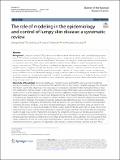| dc.description.abstract | Lumpy skin disease (LSD) is an economically important viral disease of cattle caused by lumpy disease virus (LSDV) and transmitted by blood-feeding insects, such as certain species of flies and mosquitoes, or ticks. Direct transmission can occur but at low rate and efficiency. Vaccination has been used as the major disease control method in cooperation with other methods, yet outbreaks recur and the disease still persists and is subsequently spreading into new territories. LSD has of late been spreading at an alarming rate to many countries in the world including Africa where it originated, Middle East, Asia and some member countries of the European Union except the Western Hemisphere, New Zealand and Australia. In order to take control of the disease, various research endeavors are going on different fronts including epidemiology, virology, social economics and modeling, just to mention a few. This systematic review aims at exploring models that have been formulated and/or adopted to study the disease, estimate the advancement in knowledge accrued from these studies and highlight more areas that can be further advanced using this important tool. | en_US |

